 By Bob Currie, Vessel Examiner
By Bob Currie, Vessel Examiner
U. S. Guard Auxiliary Station Galveston Flotilla
Whenever you climb into your car, you usually don’t give much thought to rain, wind, and fire. After all, it’s an enclosed vehicle (unless you have the top off or down), most cars can handle moderate wind, and cars usually don’t develop fires in normal use. Before you push away from the dock in your boat, however, you need to make sure you understand the implications of dealing with rain, wind, and fire with your boat.
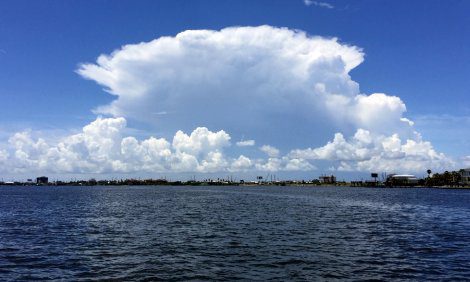
Cumulonimbus is a dense, towering vertical cloud, formed from water vapor carried by powerful upward air currents. These clouds are capable of producing lightning and other dangerous severe weather such as tornadoes and large hail. Cumulonimbus clouds progress from overdeveloped towering cumulus, and may further develop as part of a supercell. Another distinct form of cumulonimbus cloud is known as an anvil cloud (see above), or cumulonimbus incus (incus means anvil). It signifies a thunderstorm in its mature phase. I took the picture of the anvil cloud shown while on a Coast Guard Auxiliary patrol. An anvil cloud indicates very bad weather. A cumulonimbus cloud can advance from a simple cumulus cloud to a severe thunderstorm in as little as 30 minutes. This cloud is the reason you keep one eye to the sky. The average thunderstorm has a 15-mile diameter and a height of about 40,000 feet. An anvil cloud like the one pictured here generates many dangerous elements including lightning, hail, heavy rain, strong wind, and tornadoes.
So how do you deal with such a cloud formation in advance of sighting it? The best way is to consult the weather before even going out. Know what cloud formations can develop into the anvil cloud and take action to avoid such clouds. Have a plan B if you can’t reach your intended destination due to weather. In our case, the anvil cloud was blocking our return to base. We made sure the cloud was not headed our way and just stood off until the cloud passed out of the area.
Wind
Probably no other force of nature has a greater effect on the world than the wind. There are two principle causes for the production of wind. First is the principle that hot air rises and cold air sinks. This can be a localized effect as well as a global effect. In coastal areas the sea breeze/land breeze cycle can define local winds. The second is the principle of winds caused by the rotation of the planet known as the Coriolis Effect. Because surface ocean currents are driven by wind over the surface of the water’s surface, the Coriolis force affects the movements of ocean currents and cyclones as well. Recent studies show that the effect of wind over the water’s surface extends thousands of feet deep. These studies have led to a greater understanding of and a better ability to predict ocean currents.
The safe wind speed for boating is … it depends. It depends on the shape of your hull, the length and weight of your boat, and your sail area, and especially upon your experience and the experience of your crew. Flat-bottomed boats and so-called bay boats are good in light wind, but odds are they will pound in a moderate wind and be dangerous to operate in a heavy wind. Modified and deep-vee hulls cut through moderate winds but become difficult to handle in heavy winds. Winds are generally classified as follows:
- Light wind: 1-15 mph
- Moderate wind: 16-25 mph
- Heavy wind: 26-38 mph
- Gale wind: 39-54 mph
- Storm wind: 55-73 mph
If we waited for perfect weather, we wouldn’t spend much time on the water. Therefore, since the desire is to get out there, it is important to know your boat’s handling characteristics in all kinds of weather. Knowledge of how the wind affects your vessel is very important in all close quarter situations such as docking, recovery of an object in the water, and maneuvering close to another vessel. A good knowledge of how the wind affects your boat becomes critical even with light winds when it comes to approaching the loading ramp and your trailer or when coming into the dock.
The winds we are talking about above are winds in general. You can’t see them, but you can sure feel them. Let’s look at winds you can see. I am talking about waterspouts and tornados.
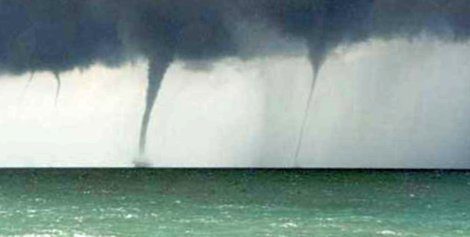
There are two types of waterspouts: fair weather waterspouts and tornadic waterspouts. I bet you can figure out which type is dangerous for boaters. According to NOAA, tornadic waterspouts are tornadoes that form over water or move from land to water. They have the same characteristics as a land tornado. They are associated with severe thunderstorms, and are often accompanied by high winds and seas, large hail, and frequent dangerous lightning. Fair weather waterspouts generally form in light winds. A neighbor of mine told me about approaching a fair weather waterspout. He was able to motor right up to it.
Fire
Before we get to the main event, here is an important public service announcement: Effective April 20, 2022, you must make sure that you have the new classification of fire extinguisher aboard. The Underwriters Laboratory (UL) label must say “Marine Type – USCG Approved.” In addition, it must not be expired (over 12 years from date of manufacture), the gauge must be in the green, and the nozzle must be clear of debris. The year of manufacture may be found either on the bottom of the fire extinguisher or on the Underwriters Laboratory UL label.
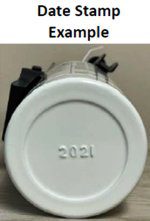 The possibility of a fire on a boat, whether it is dockside or underway, can never be completely eliminated and is always a threat. Many recreational boaters meet the minimum requirements of having a fire extinguisher on their boat but give no thoughts to prevention or to fighting a fire. This column will borrow heavily from the US Coast Guard Boat Crew Operations Manual, under which I trained and was qualified as a boat crew member. A recreational boat captain can decrease the chances of having a boat fire casualty by taking some simple precautions, by knowing the types of fires that may occur on a boat, by knowing how to prevent or fight each type of fire, and by knowing when it is time to abandon ship and save those on board.
The possibility of a fire on a boat, whether it is dockside or underway, can never be completely eliminated and is always a threat. Many recreational boaters meet the minimum requirements of having a fire extinguisher on their boat but give no thoughts to prevention or to fighting a fire. This column will borrow heavily from the US Coast Guard Boat Crew Operations Manual, under which I trained and was qualified as a boat crew member. A recreational boat captain can decrease the chances of having a boat fire casualty by taking some simple precautions, by knowing the types of fires that may occur on a boat, by knowing how to prevent or fight each type of fire, and by knowing when it is time to abandon ship and save those on board.
Priority One: Save People
A boat captain’s primary responsibility when there is a boat fire is saving lives, not property. A small fire may be extinguished with the fire extinguishers carried aboard, but if the fire develops into a large fire, the fire extinguisher’s purpose changes from extinguishing the fire to buying those aboard the time to safely abandon the vessel and hopefully get off a distress signal. The goal is to never have a boat fire, and fire prevention is the key to successfully meeting that goal.
Fire Prevention
To avoid fire, the single most important consideration is prevention. During boat and equipment checks, all systems must be inspected including the fuel, oil system, and wiring. Check for abrasions, cracked wiring, loose connections, or pinholes in oil and fuel lines. Any discrepancy must be corrected at the time it is discovered. The following are also good fire prevention measures for you to practice:
- Keep oil and grease out of bilges.
- Identify and correct any sources of fuel or oil leaks.
- Clean up any spilled fuel or lube oil immediately and properly dispose of it ashore.
- Stow cleaning materials off the boat.
- Keep all areas free of waste material.
- Use proper containers for flammable liquids.
- Be alert for suspicious odors and fumes and vent all spaces thoroughly before starting engine(s).
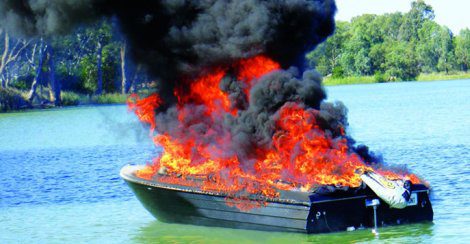
Sources of Fire on a Boat: Spontaneous Ignition
Yes, spontaneous ignition is a real thing. This source of fire is often overlooked as a cause of fire aboard a boat. Spontaneous ignition can easily occur aboard a boat if an oily or paint-soaked rag is left in the bilge or engine room. When an area is warm and there is no ventilation, an oily rag can begin to oxidize (react chemically with oxygen in the warm air around it). That oxidation produces heat, and if enough heat is produced then the rag will burst into flames. Ventilation will not remove heat, so the solution is good housekeeping- remove cleaning rags and waste. Whenever we perform vessel safety checks we always check to see that the vessel has a clean bilge or engine room.
Engine Room Fires
Engine rooms are particularly vulnerable to electrical, fuel, and oil fires. There are several ways that engine room fires can readily start. Water spraying from ruptured seawater lines can cause severe short-circuiting and arcing in electric motors (alternators), electrical panels, and other exposed electrical equipment. This, in turn, can ignite insulation and nearby combustible materials. Even more serious than leaking seawater lines are ruptured fuel and oil lines near electrical equipment. Causes of engine room fires include:
- Electrical System: The electrical system can short and cause a fire. These fires are typically small and easily controlled with either carbon dioxide (CO2) or dry chemical extinguishers. An important step is to remove the ignition source- that is, turn off the power to the electrical system by disconnecting the battery. Otherwise, the fire will reignite.
- Fuel Line: If fittings leak, fuel can drip onto a hot manifold and ignite. This situation could continue unnoticed for some time, allowing a major fire to develop when a manifold finally gets hot enough to ignite all leaked fuel.
- Lube Oil Line: This line, if leaking or ruptured, will allow lube oil to spill onto a hot engine. As the burning lube oil collects on and around an engine, the engine’s fuel supply line would probably be burned through. This would provide a fire with a continuous fuel supply, even after engines have been shut down. Fuel continuing to spill into the bilges, fires can spread and block access to the engine compartment, eventually leading to the development of a major fire.
Fighting a Fire Onboard Your Own Boat
This discussion will only include recommendations for fighting a fire onboard your own boat. It is not recommended that recreational boaters try to fight fires on boats other than their own boat that they are onboard. When you become aware of a fire onboard, use the following procedure:
- Immediately turn off the engine.
- Station your passengers away from the source of the fire.
- Make sure everyone on board is wearing a Coast Guard-approved life jacket.
- Use your fire extinguisher to put out the blaze.
Use the P.A.S.S. Method
- Pull the fire extinguisher pin
- Aim the fire extinguisher at the base of the fire
- Squeeze the fire extinguisher handle
- Sweep the fire by spraying from side to side
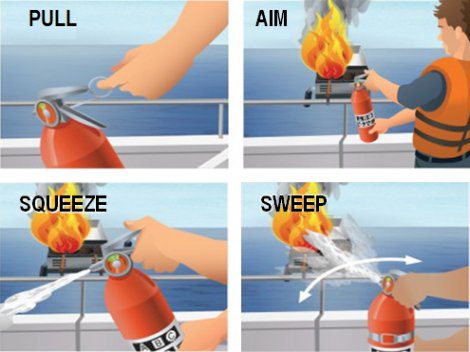
If you are unable to successfully extinguish the fire, put in a distress call to the Coast Guard on your marine radio and prepare to abandon your vessel if necessary.
Emergency Radio Call Procedures
- Make sure the radio is on
- On DSC radios, lift the cover and press Distress” button for 5 seconds and release
- Verify radio has switched to Channel 16 and go to step 5
- On non-DSC radios, change to channel 16
- Press and hold transmit button
- Clearly say “MAYDAY, MAYDAY, MAYDAY”
- Also transmit the following information while still holding the transmit button:
- Vessel Name and/or Description
- Position and/or location
- Nature of emergency
- Number of people on board
- Release the transmit button
- Wait 30 seconds – if no response, repeat the MAYDAY call
Summary
This article only discusses three of the five elements (Earth and Milla Jovovich being the other two), but don’t discount rain, wind and fire as important elements to be considered before pushing away from the dock. We are in the high wind season now, and just the other day a fishing boat was pushed up on the Galveston North Jetty and destroyed, while just last week a commercial shrimp boat was destroyed in very few minutes when it had an electrical fire in the engine room. The crew could only abandon ship it happened so quickly. Keep an eye to the sky and, as the watch commander on Hill Street Blues always said, let’s be safe out there.
[BC: Mar-21-2023]

 Posted in
Posted in 























